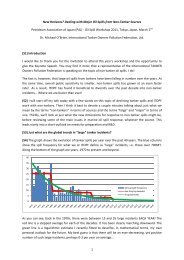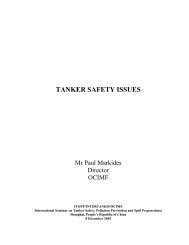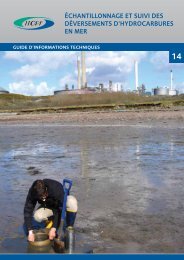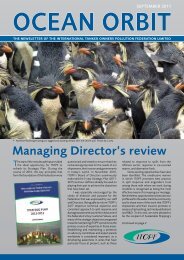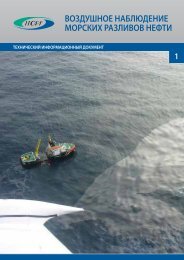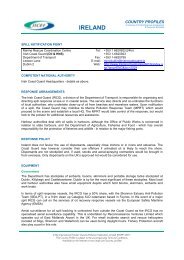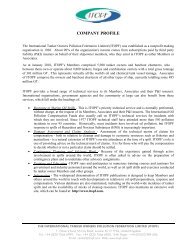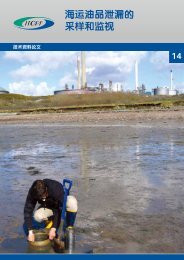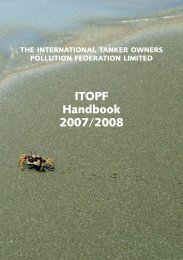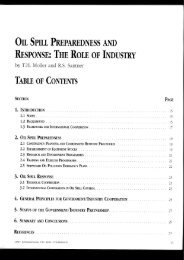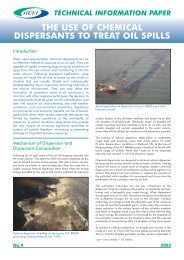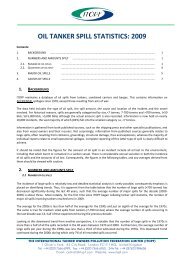Create successful ePaper yourself
Turn your PDF publications into a flip-book with our unique Google optimized e-Paper software.
<strong>ITOPF</strong> - News<br />
http://www.itopf.com/amorgos.html<br />
Page 1 of 3<br />
01/11/2007<br />
<strong>AMORGOS</strong><br />
<strong>AMORGOS</strong>, Oil Pollution Incident, Lungpan, Taiwan, 14th January 2001 -<br />
Update 6th July 2001<br />
The final stage of shoreline cleanup was completed toward the end of May to the satisfaction of the<br />
Taiwanese authorities and disposal of the last of the recovered liquid oil and oily debris was<br />
completed around the end of June. There remains some restoration work to be done on access<br />
tracks to some shoreline areas. <strong>ITOPF</strong> continues to work closely with the authorities and relevant<br />
parties on the assessment and resolution of various claims and an environmental monitoring<br />
programme is underway.<br />
6 July 2001<br />
<strong>AMORGOS</strong>, Oil Pollution Incident, Lungpan, Taiwan, 14th January 2001 -<br />
Update 16th March 2001<br />
In spite of stormy conditions, the <strong>AMORGOS</strong> remains stable and there are no reports of any further<br />
serious leakage of oil. The vessel's owners have engaged a diving contractor to attend the wreck.<br />
Their attempts to recover oil remaining on board have been hampered by rough seas, but on 6th<br />
March some 500-600 litres were removed from cargo hold number 3. A further 4.2 tonnes were<br />
removed on 12th March and around 20 tonnes on 16th March. A small amount of oil was washed out<br />
of the cargo hold during strong tides on 10th March, but this was dealt with using sorbent pads.<br />
The weather conditions have also hampered cleanup efforts. Storms earlier in the month remobilised<br />
oil remaining in channels in the central section of the shore and carried it to channels to the south that<br />
had previously been cleared. In places, strong sunlight and high daytime temperatures are also<br />
causing thin coatings of oil to dry and harden on the rocks. In areas exposed to high wave energy,<br />
natural cleaning is occurring, but away from the surf zone and towards the upper reaches of the<br />
channels, the wave/water energy is lower and natural flushing is much less evident.<br />
Some 400 people are presently engaged on shoreline clean-up. The majority have been sieving oil<br />
that has already been collected to remove debris that would otherwise block the transfer pumps.<br />
Between them, they have been handling up to 32 tonnes of oil each day. This operation will be<br />
completed around 17th March and the final stage of clean-up will then commence. Tests to evaluate<br />
the most appropriate clean-up techniques for the situation are currently being arranged.<br />
The removal of oily debris from beneath the amenity area viewpoints, which overlook the affected<br />
shore, has now been largely completed. A wood chipper arrived on site on 11th March and has been<br />
used to chip some of the large pieces of timber that have been collected.<br />
Substantial progress has been made with the removal of oil and oily debris from the site. 80-90 cubic<br />
metres of debris is being removed each day and 18-20 tonnes of liquid oil.<br />
Mr Richard Santner is presently on-site.<br />
Click here to view a selection of photographs from the scene.<br />
20 March 2001
<strong>ITOPF</strong> - News<br />
http://www.itopf.com/amorgos.html<br />
Page 2 of 3<br />
01/11/2007<br />
<strong>AMORGOS</strong>, Oil Pollution Incident, Lungpan, Taiwan, 14th January 2001<br />
- An Update<br />
Military personnel withdrew on 16th February, having manually cleared most of the heavy<br />
accumulations of oil between the rock crevices and moved much of the oversized oiled driftwood into<br />
piles at the back of the beach. On 17th February about a hundred workers from the local villages took<br />
over the clean-up operation under the direction of a spill contractor appointed by the vessel's owners.<br />
Local workers currently number some 300 and are continuing to focus efforts on transferring oil and<br />
oiled driftwood and debris to storage areas at the back of the beach and manually removing<br />
accumulations of floating oil from the water between the rock channels, as weather conditions permit.<br />
As at 27th February, about 10-15% of the oil recovered from the sea had been moved from the<br />
shoreline to a temporary storage area at the top of the cliff awaiting final disposal. The first loads of<br />
solid waste have been taken to an incinerator and arrangements for recycling fluid oil are being<br />
finalised.<br />
Oil sheens are still spreading from the tanks damaged at the time of the grounding, but dissipate<br />
within about 500m of the wreck site, before reaching shore. Some of the cargo of iron ore fines is also<br />
visible in the water but is being quickly dispersed in the strong currents. The Taiwanese authorities<br />
remain concerned about the status of the broken vessel and the possibility of further oil being<br />
released. Salvage experts are currently assessing the best way forward.<br />
Mr Richard Santner of <strong>ITOPF</strong> is on-site.<br />
2 March 2001<br />
<strong>AMORGOS</strong>, Oil Pollution Incident, Lungpan, Taiwan, 14th January 2001<br />
Whilst en-route from India to North China, the bulk carrier <strong>AMORGOS</strong>, laden with 60,000 tonnes of<br />
iron ore, suffered engine failure and grounded on rocks off the southern tip of Taiwan. An estimated<br />
1000 tonnes of the fuel oil on board at the time of the grounding has since spilt into the sea.<br />
Measures to mitigate the loss of oil from the vessel were taken by Smit Tak, an international salvage<br />
firm engaged by the vessel's owner. They completed oil removal operations on 4th February. A total<br />
of about 220 tonnes of IFO 180 was removed from the vessel's breached or damaged tanks. A<br />
maximum of some 200 tonnes of IFO 180 now remains on board distributed among 6 tanks. These<br />
tanks are reportedly sound and the probability of a further significant release of oil is low, though<br />
minor leakage is occurring.<br />
Approximately 4-5km of shoreline within the Kenting National Park has been oiled to varying degrees.<br />
The Kenting National Park is a scenic and ecologically important area that draws thousands of<br />
tourists. It is well known for its limestone caves, natural monsoon forests and coastal tropical<br />
rainforest and supports an estimated 2,200 different plant species, some of which are rare and<br />
unusual. Approximately 200 bird species also inhabit or migrate through the park.<br />
Much of the affected shoreline consists of jagged fossilised coral rock, pitted with channels. The first<br />
kilometre north of the Oluanpi headland is most heavily affected but some channels further away also<br />
contain substantial amounts of oil. Of the 1000 tonnes or so that has been spilt, some will have been<br />
lost through dispersion and evaporation, but much has reached the shoreline. The oil has now<br />
emulsified, due to the constant wave/water mixing, increasing the overall quantity of material to be<br />
recovered.<br />
Both the salvage and the response operation have been hampered by poor weather conditions.<br />
Though the rough seas and high winds have promoted the natural dispersion of the oil, they have<br />
hindered the mobilisation of manpower and equipment. In the initial stages of the response, problems<br />
were further exacerbated by the difficulties of finding workers during the Chinese New Year holidays.
<strong>ITOPF</strong> - News<br />
http://www.itopf.com/amorgos.html<br />
Page 3 of 3<br />
01/11/2007<br />
Owing to the severe weather, response at sea has been restricted to the manual recovery of oil using<br />
hand nets and scoops. Local fishermen have been employed in this respect. A launch vessel with<br />
dispersants remained on stand-by until 3rd February, but was demobilised once the risk of a further<br />
substantial release of oil had been minimised through Smit Tak's oil removal operations. No<br />
dispersant was applied prior to this due to the storm conditions prevalent when the oil was first spilt.<br />
Shoreline clean-up operations began on 25th January. 37 labourers and supervisors were initially<br />
deployed, though this number was increased to 150 by the beginning of February. Cleaning consists<br />
of the manual collection of thick pools of oil within the rock channels. The shore terrain is very rough<br />
and it has not been possible to use machinery directly along the rock areas. The collected oil has<br />
therefore been moved in buckets along a human chain to a staging area of storage tanks at the back<br />
of the shore amongst the rocky cliffs. The oil has then been transferred to a storage site at the top of<br />
the cliffs using screw pumps and a network of PVC piping. It will ultimately be removed to the China<br />
Petroleum Corporation's facilities at Kaoshiung for final disposal.<br />
The local workforce has now been joined by several hundred soldiers, who arrived on-site on 11th<br />
February to assist with the manual clean-up operation. On 13th February some 62 tonnes of oily<br />
waste were collected, bringing the total to some 300 tonnes as at 14th February.<br />
Dr Karen Purnell of <strong>ITOPF</strong> is currently on-site. She has replaced Chantal Guénette and Richard<br />
Santner who were earlier in the field.<br />
20 February 2001



